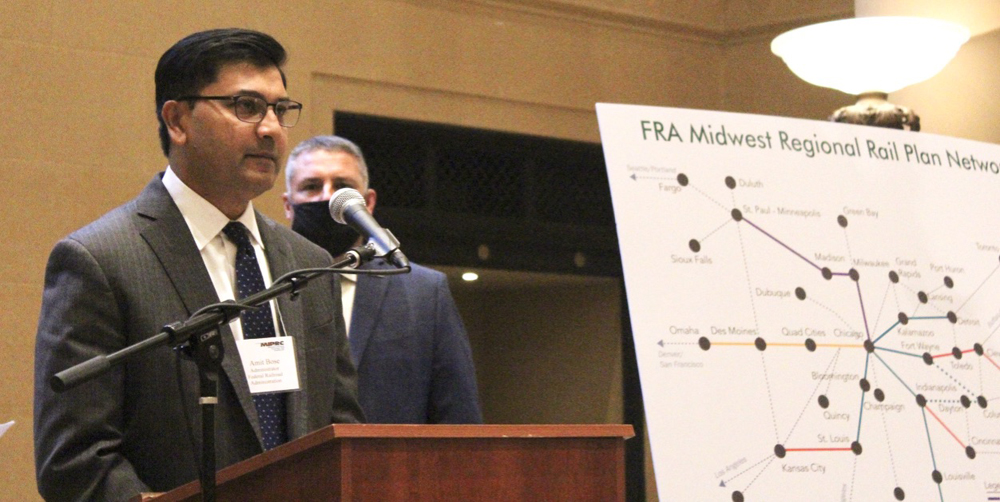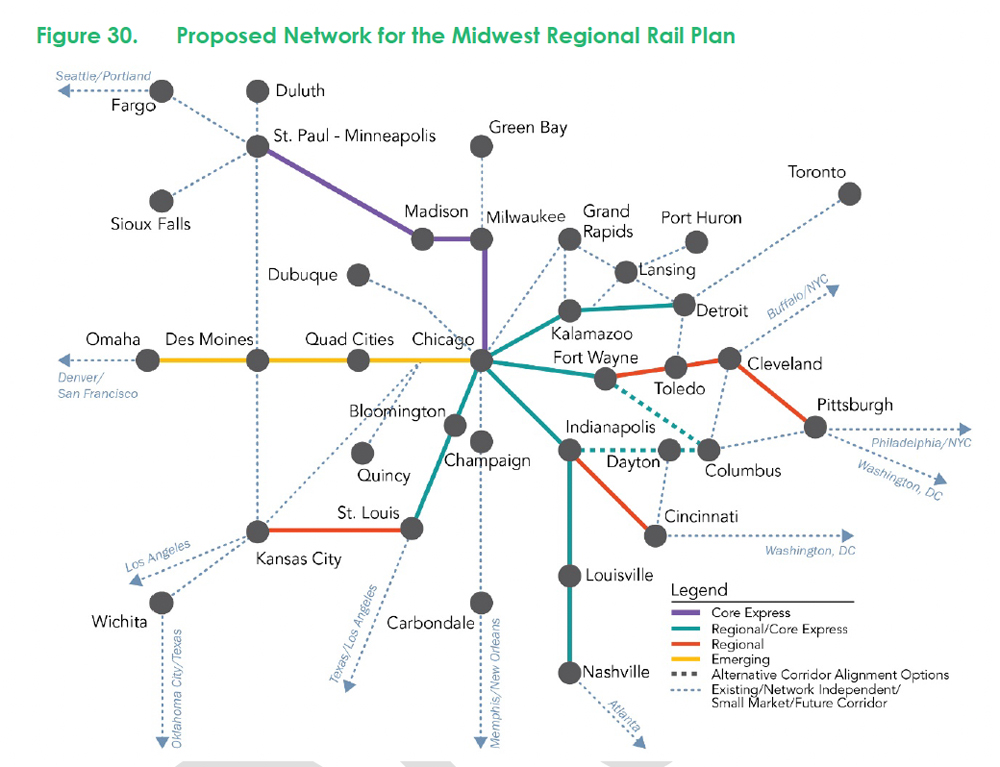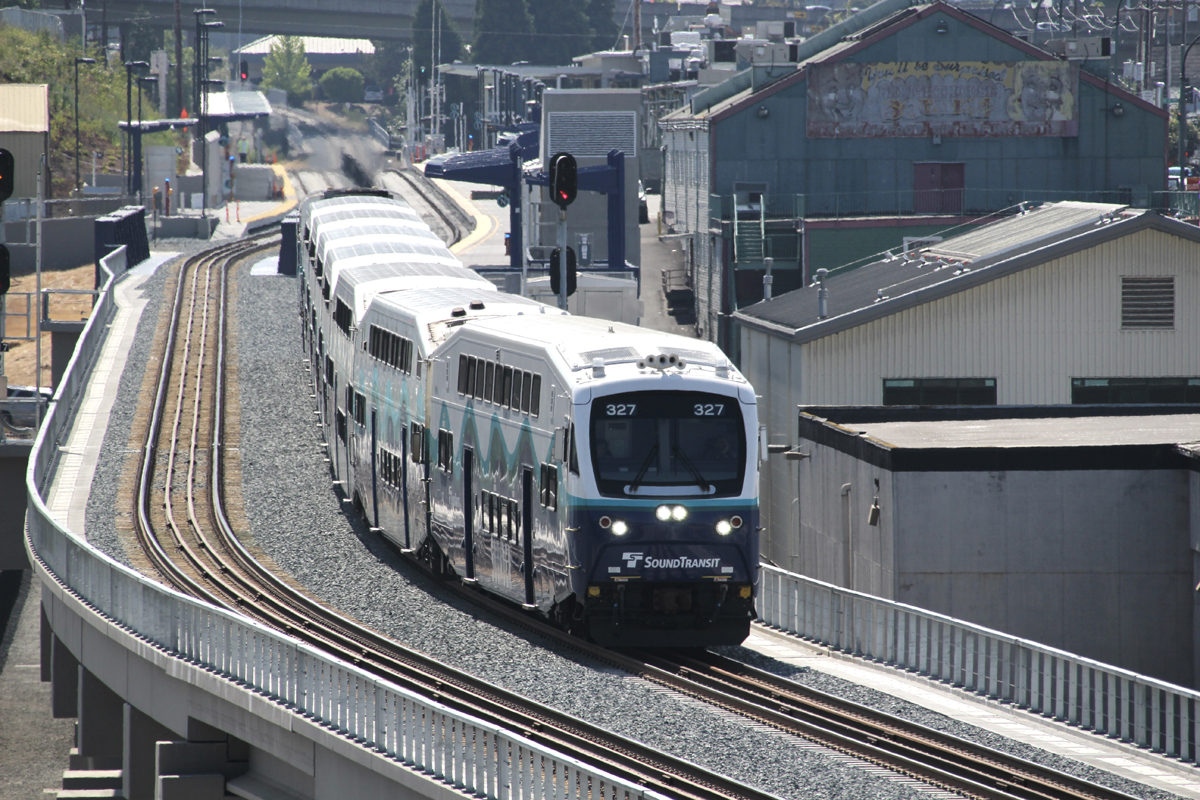
CHICAGO — Deputy Federal Railroad Administrator Amit Bose released the agency’s Midwest Regional Rail Plan at a Chicago Union Station media event Wednesday, characterizing it as “a 40-year multi-state framework and vision for restoring, modernizing, and expanding the existing intercity passenger rail network in the Midwest.”

The blueprint, a culmination of two years collaborative work between the FRA, Amtrak, interested stakeholders such as the Midwest Interstate Rail Commission (MIPRC) and 12 state departments of transportation, prioritizes varying levels of additional infrastructure investment on different routes, as outlined on the schematic map that accompanies the report. The full 198-page report is available here.
These include four primary “Core Express” routes radiating from Chicago to Milwaukee, Madison, Wis., and the Twin Cities; St. Louis; Detroit; and Indianapolis. These would feed corridors linking other cities. This is the third FRA regional study, following similar rail plans for the Southeast and Southwest.
“For too long, passenger rail has been the forgotten mode, in the sense that it lacks the sustained funding stream afforded to other forms of transportation. The time has come to change that,” Bose notes, adding, “The bipartisan Infrastructure Investment and Jobs Act pending before Congress represents the largest investment in intercity rail since the founding of Amtrak.”
The “once in a generation investment,” he says, also provides for interstate compact programs, “such as the one underpinning the plan released today.”
After the announcement, Bose and members of MIPRC boarded Amtrak Wolverine train No. 352 for Dearborn, Michigan, where the compact’s annual conference is taking place Thursday.
Trains News Wire is monitoring the session and will have additional comments from the Bose in an upcoming interview.














Another consultants’ payday.
For some reason, the government transportation agencies (especially rail) LOVE to blow money on “studies”
I suspect a shuttle of people between government jobs and consultant jobs.
Chicago-Sioux Falls would be better via Omaha than Minneapolis-St. Paul. The map is incorrect, S.F. is a little closer to Omaha than it is to Mpls./St.P. I realize it’s only a schematic, but you kind of wonder how much thought went into this. I don’t know if much of a rail infrastructure exists S.F.-Mpls./St.P. or how direct it is, but rail definitely exists S.F.-Omaha (or at least Council Bluffs). And probably more population coming up from Omaha, i.e. Sioux City, than coming down from Mpls./St.P.
Overall, this plan requires an enormous investment in infrastructure.
How hard would it have been to include the original River Runner from KC to New Orleans into the plan? Talk about a corridor with Amtrak already plying most of the original River Runner route, has existing stations in place, connects two midwest metro areas with two southern metro areas with a viable traffic base.. No need to reinvent the wheel and you have corridor with population of say 8-10 million if not mistaken.
…
Too some of the comments above; certainly agree another day, another dollar and another plan/study & those who produced it pat each other on the back that we have accomplished something. We haven’t accomplished anything. What we is show how much fragmentation there is, how cooks are in the kitchen, and we once again try to appease everyone. That is certainly hurting the one corridor in Chicago to Milwaukee where some success could be had in a sustainable farebox ridership but expanding rail capacity it tied up by northern Chicago suburbs push back.
..
Don’t have a solution short of we needing to be a communist country but do believe we need to get some promises full filled on existing corridors before going down the road of adding more infrequent less then desireable service to appease everyone.
Now that you have routes defined, put each one out to bid like they do with spectrum. Set a minimum bid level to cover what Amtrak has to pay the hosting railroad. In the bid contract state what the time slot is and what the requirements are.
Treat it like we do the commercial space program. It would be interesting to see what some firms put together. Provide *cash* or tax incentives to use alternate motive power schemes, like hydrogen, battery electric, or other LEV technologies.
Let those carriers sell their clean energy credits they are generating
Not sure how they plan to get from Indianapolis to Dayton and Columbus, since the xPRR double track was pulled out when I was a wee lad. I learned in the Army, that some officers felt their importance was in direct proportion to the paper work they generated, rather than to any measurable concrete accomplishments. Ho humm, we will be fortunate to see ONE route established.
This study is about 3-4 years in production. There was at least some level of freight participation, though mostly from the sidelines watching. The study, at least at the onset was not looking at specific railroads or alignments.
That said, great to have a plan, but implementation is where its at and this general plan has been out there before. It doesn’t take a lot to determine the value of a Chicago Hub with lines reaching the major midwest cities.
Another year another plan. Millions have been spent on studying and restudying the 3C corridor in Ohio. Millions. Enough to start up and run an actual service. But we’ll have another study that says service is wanted and no trains will yet be running.
I’m still waiting for improved transit times between Chicago and St Louis. How many years since that corridor was designated to be “higher” speed. But the transit times are slower today than in the 50″s.
Remmeber, the NE corridor between Washington and NYC is still mostly 1930″s catenary. And on and on..
Hopefully that 40 year plan is very conservative or they’ll still be talking about it in 40 years. They have a plan that took two years, now is the time to start acting on that plan. Include a by-pass or two around Chicago though or it will just jam up the main hub.
Shouldn’t the emphasis be on building up ridership and revenues on existing corridors back to near pre pandemic levels first before chasing after other routes and services?
When everyone is required to drive an electric car by 2035, the return of the passenger train will happen.
My first thought when reading this is what do the freight railroads whose lines will have to be used think of all this? They didn’t seem to be consulted at all in this study.
I’m not anti-passenger by any means, and I actually think a lot of these proposed corridors make plenty of sense, but I can’t help but get the feeling that the passenger people look at the “pro-passenger” administration in the White House and think they can throw around any idea and that’ll get funding…
Amtrak or any potential passenger train operators. Play nice with the freight Railroads and they’ll play nice with you.
No so sure about that one. I’ve encountered many people in my life who mistook kindness for weakness. Leo Durocher was right.
Passenger rail is not the “forgotten mode”, it has had a “funding stream”, and the federal infrastructure legislation is hardly “bipartisan”.
Among all other problems, all the challenges to create a viable Chicago hub, starting off with three talking points which stretch the truth is, well, how stuff is done in Washington. And why little comes of it.
Noted missing from the above list of interest groups is AAR or its constituent rail carriers.
Then there is the proposed Chicago to Madison corridor, connecting Chicago to that booming and prosperous center of business, education and state government but lacking any decent rail infrastructure.. The best Amtrak has done so far was the Chicago to Janesville (Wisconsin) train, whose ridership over its several years of operation was miniscule. Including the station at “Lake Geneva”, in reality a bleak platform in a cornfield eight or ten miles out of town.
Folks, there’s a difference between a study group and a rail hub, a difference that tens billions of dollars the government doesn’t have cannot bridge.